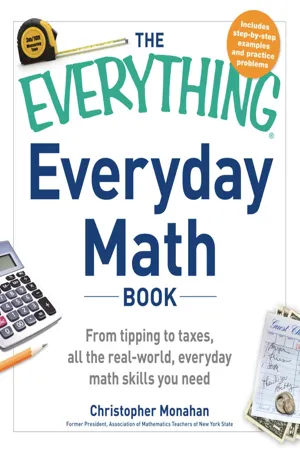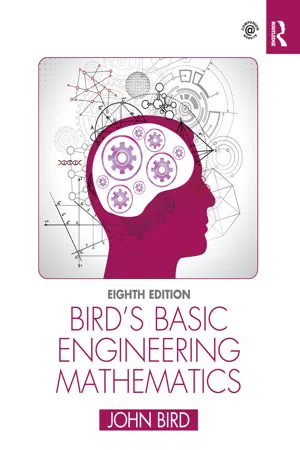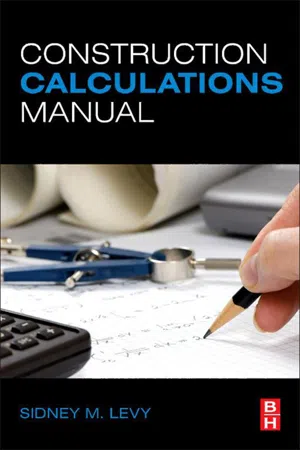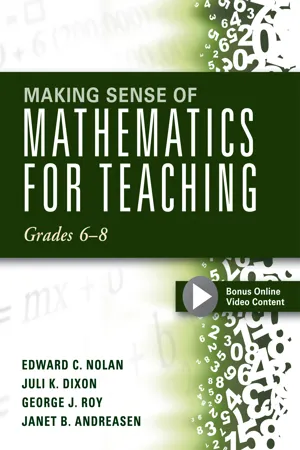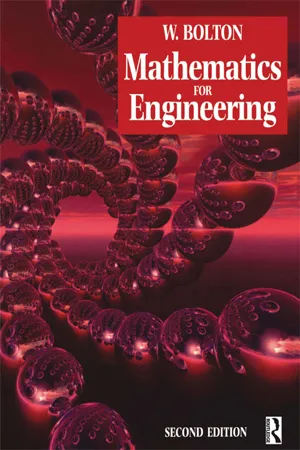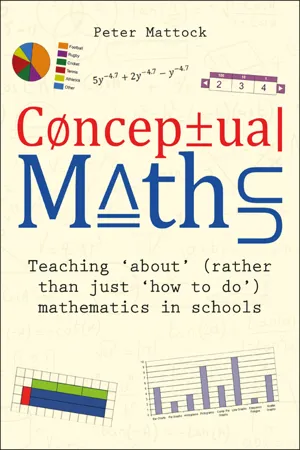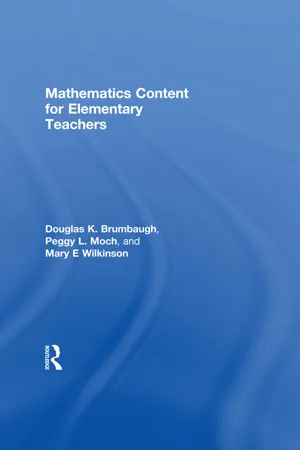Mathematics
Volume of Pyramid
The volume of a pyramid is the measure of space enclosed by its three-dimensional shape. It is calculated using the formula V = (1/3) * base area * height, where the base area is the area of the pyramid's base and the height is the perpendicular distance from the base to the apex. This measurement is important in geometry and engineering for determining the capacity or space occupied by pyramidal structures.
Written by Perlego with AI-assistance
Related key terms
10 Key excerpts on "Volume of Pyramid"
- eBook - ePub
The Everything Everyday Math Book
From Tipping to Taxes, All the Real-World, Everyday Math Skills You Need
- Christopher Monahan(Author)
- 2013(Publication Date)
- Everything(Publisher)
Area measurements are given in square units. When you multiply feet by feet, the answer is in square feet.Volume
There are essentially three shapes that make up the basic solids whose volume formulas are known: the prism, the pyramid, and the sphere. The prism is a solid whose top and bottom (the bases) are exactly the same shape and size. The pyramid can have any shape as the base, but all the lateral edges come to a point (similar to the pyramids in Egypt—the difference between the pyramids in Egypt and the mathematical definition of a pyramid is that in math the base does not have to be a rectangle). The sphere is a ball (or a three-dimensional circle, if you prefer).Three special cases of solids are usually identified. A prism with all sides of equal length, and all angles right angles, is called a cube . A prism with a circular base is called a cylinder . A pyramid with a circular base is called a cone . Because the base for the prism and the pyramid can be any shape, the formula for the volume is given in terms of the area of the base, B .Volume of a CubeA = s 3Volume of a PrismA = B × hVolume of a PyramidA = × B × hVolume of a CylinderA = π × r 2 × hVolume of a SphereA = × π × r 3Volume of a ConeWhereas area is measured in square units, volume is measured in cubic units.A = × π × r 2 × hExample: Find the volume of a cube that measures 5 cm on each side.The volume of a cube is s 3 , so the volume of this cube is 5 × 5 × 5 = 125 cubic centimeters, or 125 cu. cm, or 125 cm3 . (In the medical field, the cubic centimeter is often abbreviated as cc.)Example: The base of a rectangular box has dimensions 8 in. by 12 in. What is the height of the box if the volume of the box is 480 in3 ?The base of the box is a rectangle, and the area of a rectangle is l × w . For this box, the area of the base is 8 × 12 = 96 in2 . Solve 96 × h = 480 to get h = 5 in.Example: You have two pitchers that are both in the shape of a cylinder. One of the pitchers has a radius of 4 in. and a height of 8 in. The other pitcher has a radius of 3 in. and a height of 15 in. Which pitcher has the greater capacity? - eBook - ePub
- John Bird(Author)
- 2021(Publication Date)
- Routledge(Publisher)
For the square-base pyramid shown, v o l u m e = 1 3 x 2 h Figure 28.9 Problem 9. A square pyramid has a perpendicular height of 16 cm. If a side of the base is 6 cm, determine the volume of the pyramid Volume of Pyramid = 1 3 × area of base × perpendicular height = 1 3 ×(6 ×6)×16 = 192 cm 3 Problem 10. Determine the volume and the total surface area of the square pyramid paperweight shown in Fig. 28.10 if its perpendicular height is 12 cm. Volume of Pyramid = 1 3 (area of base) × perpendicular height = 1 3 (5×5)×12 =100 cm 3 Figure 28.10 The total surface area consists of a square base and 4 equal triangles. Area of triangle ADE = 1 2 × base × perpendicular height = 1 2 × 5 × A C The length A C may be calculated using Pythagoras? theorem on. triangle A B C, where A B = 12 cm and B C = 1 2 × 5 = 2.5 cm A C = A B 2 + B C 2 = 12 2 + 2.5 2 = 12.26 cm Hence, area of. triangle A D E = 1 2 × 5 × 12.26 = 30.65 cm 2 T o t a l s u r f a c e a r e a o f p y r a m i d = (5 × 5) + 4 (30.65) = 1 4 7. 6 c m 2 Problem 11. A rectangular prism of metal having dimensions of 5 cm by 6 cm by 18 cm is melted down and recast into a pyramid having a rectangular base. measuring 6 cm by 10 cm. Calculate the perpendicular height of the pyramid, assuming no waste of metal Volume of rectangular prism = 5 × 6 × 18 = 540 cm 3 Volume of Pyramid = 1 3 × area of base × perpendicular height Hence, 540 = 1 3 × (6 × 10) × h from which, h = 3 × 540 6 × 10 = 27 cm i.e. perpendicular height of pyramid = 2 7 c m Cones A cone is a circular-based pyramid. A cone of base radius r and perpendicular height h is shown in Fig. 28.11 Volume = 1 3 × area of base ×perpendicular height Figure 28.11 i.e. V o l u m e = 1 3 π r 2 h C u r v e d s u r f a c e a r e a = π r l T o t a l s u r f a c e a r e a = π r l + π r 2 Problem 12. Calculate the volume, in cubic centimetres, of a solid wooden cone of radius 30 mm and perpendicular - eBook - ePub
- Sidney M Levy(Author)
- 2011(Publication Date)
- Butterworth-Heinemann(Publisher)
If you take any circle, measure its circumference and its diameter, and divide the circle's circumference by its diameter, the answer is always 3.1416. This ratio of the circumference to the diameter is always the same, regardless of the size of the circle or its units of measure.Volume of a cylinder
volume = (pi / 4) × a2 × b and volume = pi × a/2 × a/2 × bVolume of a frustum of a pyramid
Volume of a cone
Volume of a frustum of a cone
Frustum's surface area
Tangent Examples: tangent 30° = 0.57735 tangent 35° = 0.70021 tangent 40° = 0.83910 tangent 45° = 1.00000 tangent 50° = 1.19175 tangent 55° = 1.42815 tangent 60° = 1.73205 tangent 65° = 2.14451 tangent 70° = 2.74748Volume of a sphere
Area of a circle
A circle's area can be determined by using either the radius or the diameterCircumference of a circle
Volume of a pyramid
3.2.1 Volume of Prisms
Right Prism Volume Postulate
The volume V of any right prism is the product of B , the area of the base, and the height h of the prism.(The base's formula could change depending on the base's shape.)Formula:3.2.2 Volume of Pyramids
Pyramids
A pyramid is a polyhedron with a single base and lateral faces that are all triangular. All lateral edges of a pyramid meet at a single point, or vertex .Pyramid Volume Theorem
The volume V of any pyramid with height h and a base with area B is equal to one-third the product of the height and the area of the base.Formula:3.2.3 Area of Prisms and Right Area Prisms
There are special formulas that deal with prisms, but they only deal with right prisms. Right prisms - eBook - ePub
Making Sense of Mathematics for Teaching Grades 6-8
(Unifying Topics for an Understanding of Functions, Statistics, and Probability)
- Edward C. Nolan, Juli K. Dixon(Authors)
- 2016(Publication Date)
- Solution Tree Press(Publisher)
figure 5.24 ). How are their volumes related?If you filled the pyramid with water and poured it into the prism, how high do you think it would fill the prism? Figure 5.25 (page 120 ) shows a pyramid and its related prism after water from a full pyramid has been poured into the prism one time.Figure 5.24: Prism and pyramid with the same base and same height.The contents of one pyramid fill the prism ⅓ full. Therefore, the volume of a prism is three times the volume of a pyramid with the same area of the base and height, soVpyr= ⅓ Bh .The processes involved in developing formulas for area, surface area, and volume provide opportunities to engage students in Mathematical Practice 7, “Look for and make use of structure,” as they connect the structures of shapes to each other. When students apply these formulas to make sense of solving contextual problems that apply area, surface area, and volume concepts, they engage in Mathematical Practice 4, “Model with mathematics.” Throughout middle-grades mathematics, as students explore and make sense of area, surface area, and volume of various shapes, context problems become more complex to include additional shapes that students must decompose. Success with these sorts of problems is improved when students are able to visualize the decompositions. Visualization is also used when exploring transformations.Figure 5.25: Contents of a pyramid poured into a prism.Using Transformational Geometry
As students transition from grades 6–8 into high school, transformations are incorporated not only in the geometry curriculum, but in algebra as well. Transformations include four main types: (1) reflections, (2) translations, (3) rotations, and (4) dilations. Each transformation impacts shapes in different ways. Transformations are used to examine ideas of congruency and similarity as well as scale factor in meaningful ways.Consider the transformations task in figure 5.26 . You may want to make a copy of the diagrams in figure 5.26 - eBook - ePub
- W Bolton(Author)
- 2012(Publication Date)
- Routledge(Publisher)
cone is used.Figure 2.17 PyramidsThe term right pyramid is used when the apex is vertically above the centre of the base, otherwise the term oblique pyramid is used. If we think of a right pyramid as built up from a number of layers, then sliding successive layers over another generates an oblique pyramid will the same volume (Figure 2.18 ). A right pyramid and an oblique pyramid will have the same volumes if their base areas are the same and their vertical heights equal.Figure 2.18 Right and oblique pyramidsThe volume V of any pyramid is:V = × area of base × perrpendicular heightThis can be demonstrated by first considering a triangular-based prism (Figure 2.19 ). Diagonal planes can be used to divide the prism into three equal volume triangular-based pyramids ABCE, DEFC and BCDE. Thus, since the volume of the prism is the base area multiplied by the perpendicular height, the volume of the triangular prism is one third the base area multiplied by the perpendicular height. This argument applies to other prisms.Figure 2.19 A prism divided into pyramidsThe total surface area of a pyramid is the sum of the areas of the triangles forming the sides plus the area of the base.A cone with a base of radius r and vertical height h (Figure 2.17(c) ) has a base area of πr2 and thus the volume V of a cone is:V = πr2 hThe area of the curved surface of a cone may be obtained by imagining the cone surface to be a sheet of paper which is cut along the line OA and then unrolled onto a flat surface (Figure 2.20 ). The sheet is a segment of a circle with a radius equal to the slant height l of the cone and segment having a circumference equal to that of the cone, i.e. 2πr. The area of a circle of radius l is πl2 and its circumference is 2πl; thus the area of a segment with an arc length 2πr is (2πr/2πl) × πl2 = πrl - eBook - ePub
Conceptual Maths
Teaching 'about' (rather than just 'how to do') mathematics in schools
- Peter Mattock(Author)
- 2023(Publication Date)
- Crown House Publishing(Publisher)
.Similarly, the volume of a cone can be found by treating it as analogous to a pyramid, being a third of the volume of the containing cylinder. However, it is more difficult to visualise this than with a square or rectangular pyramid (where we can show pyramids attached to the side of the prism as well as the base); however, there are nice video demonstrations that involve filling a cone-shaped container with water and pouring it into a cylindrical container with the same base circle (as demonstrated in the video linked below27 ).This leads to the volume of the cone formula being equal to πr2 h, or alternatively . One thing that pupils need to be clear on here is the use of the vertical height when calculating the volume of a cone, which is in contrast to the use of the slant height when calculating the curved surface area. Offering pupils opportunities to work with both of these is important to make sure pupils use the correct lengths in the correct situations.When it comes to finding the volume of the sphere, again typically calculus would be used to derive the formula; however, there are similar demonstrations to the one above: particularly showing that the sphere of radius r (and therefore diameter 2r) can be filled with a cone with height 2r (and therefore volume of πr3 ) twice over leading to the conclusion that the volume of the sphere can be calculated by πr3 .28 There is also a derivation of the formula that doesn’t require calculus, but does require Pythagoras’ theorem and a reasonable amount of geometric knowledge and insight. The proof rests around demonstrating that when a hemisphere is placed inside a cylinder with the same height and radius (as per the next image) it is possible to show that the space inside the cylinder outside of the hemisphere is equal to the space taken up by a cone with the same radius and height as the cylinder.389 - eBook - ePub
- John Bird(Author)
- 2019(Publication Date)
- Routledge(Publisher)
Chapter 14 Volumes of common solidsWhy it is important to understand: Volumes of common solidsThere are many practical applications where volumes and surface areas of common solids are required. Examples include determining capacities of oil, water, petrol and fish tanks, ventilation shafts and cooling towers, determining volumes of blocks of metal, ball-bearings, boilers and buoys, and calculating the cubic metres of concrete needed for a path. Finding the surface areas of loudspeaker diaphragms and lampshades provide further practical examples. Understanding these calculations is essential for the many practical applications in engineering, construction, architecture and science.At the end of this chapter, you should be able to:- state the SI unit of volume
- calculate the volumes and surface areas of cuboids, cylinders, prisms, pyramids, cones and spheres
- appreciate that volumes of similar bodies are proportional to the cubes of the corresponding linear dimensions
14.1 Introduction
The volume of any solid is a measure of the space occupied by the solid. Volume is measured in cubic units such as mm3 , cm3 and m3 .This chapter deals with finding volumes of common solids; in engineering it is often important to be able to calculate volume or capacity, to estimate, say, the amount of liquid, such as water, oil or petrol, in differently shaped containers.A prism is a solid with a constant cross-section and with two ends parallel. The shape of the end is used to describe the prism. For example, there are rectangular prisms (called cuboids), triangular prisms and circular prisms (called cylinders).On completing this chapter you will be able to calculate the volumes and surface areas of rectangular and other prisms, cylinders, pyramids, cones and spheres. Volumes of similar shapes are also considered.14.2 Calculating volumes and surface areas of common solids
Science and Mathematics for Engineering. 978-0-367-20475-4, © John Bird. Published by Taylor & Francis. All rights reserved.14.2.1 Cuboid or rectangular prism
- Richard Lehrer, Leona Schauble(Authors)
- 2023(Publication Date)
- Routledge(Publisher)
Shortly after these initial qualitative explorations, students begin to find and compare volumes by employing units. As with length and surface area, an important conceptual achievement in understanding volume is coming to understand the properties of units of volume. Students recognize that the units used to measure must be the same or, if not, distinctly labeled, and units need to tile, or completely fill, the volume being measured. Students’ work at this level begins with rectangular prisms. Later, when they encounter other 3-D shapes (such as cylinders), the nature of units may need to be reconsidered, because students have a tendency to favor units that bear a perceptual resemblance to the figure being measured. For example, they may be drawn to using beads to fill the volume of a cylinder because both the beads and the cylinder are “curvy.” However, students usually recall readily that they have already resolved this issue of resemblance in the context of area and quickly reject the solution based on similarity because it does not meet the criteria of avoiding both “gaps” and “overlaps” of measure so that units entirely fill the three-dimensional space.As they first attempt to measure the volume of rectangular prisms, students find volume by counting unit cubes in structures in which all the cubes are visible. Much of the instruction in the early grades is aimed toward helping students differentiate the area of 3-D figures from their volume, but also to perceive the relations between these two attributes in any three-dimensional shape. In Volume unit 1 of Measuring and Visualizing Space, students compare the surface areas of three different “apartment buildings” (that is, prisms) constructed of interlocking cubes. Each building is composed of 12 cubic “apartments” with the following dimensions: 1 × 1 × 12 cubes, 2 × 2 × 3 cubes, and 6 × 1 × 2 cubes. Surface area is contextualized as the windows, roof, and footprint of the building. Students next compare the volume enclosed or occupied by each building—that is, the number of “apartments” that each building holds. In this introductory task, the context supports children in differentiating surface area (e.g., the number of windows, roof, and building footprint) from volume (e.g., the total number of apartments enclosed in each building). Students also find that even though the surface areas of the three buildings vary, their volume measures are the same. The lesson was originally designed for classes of second-grade students, but it can also serve as an entrée to volume measure in later grades.- (Author)
- 2023(Publication Date)
- Kaplan Test Prep(Publisher)
More complicated 3D shapes include the right pyramid, right cone, and sphere. The vertex of a right pyramid or right cone will always be centered above the middle of the base. Their volume formulas are similar to those of prisms, albeit with different coefficients.Some of these formulas might look daunting, but you won’t have to memorize them for test day; they’ll be provided in the question stem if they are needed.Right Rectangular Pyramid Right Cone Sphere A right pyramid can have any polygon as its base, but the square variety is the one you’re most likely to see on the ACT. Also note that the vertex above the base of a right pyramid or cone is not necessarily formed by an intersection of exactly three faces, as in prisms, but it is still a single point and is still called a vertex.Surface Area
Surface area is the sum of the areas of all faces of a solid. To calculate the surface area of a solid, simply find the area of each face using your 2D geometry skills, then add them all together.You won’t be expected to know the surface area formulas for right pyramids, right cones, and spheres. They’ll be provided at the beginning of each Math section. However, you could be asked to find the surface area of a prism, in which case you’ll be given enough information to find the area of each surface of the solid.You might think that finding the surface area of a solid with many sides, such as a right hexagonal prism, is a tall order. However, you can save time by noticing a vital trait: this prism has two identical hexagonal faces and six identical rectangular faces. Don’t waste time finding the area of each of the eight surfaces. Find the area of one hexagonal face and one rectangular face only. Then multiply the area of the hexagonal face by 2 and the area of the rectangular face by 6, add the products together, and you’re done. The same is true for other 3D shapes such as rectangular solids (including cubes), other right prisms, and certain pyramids.- eBook - ePub
- Douglas K. Brumbaugh, Peggy L. Moch, MaryE Wilkinson(Authors)
- 2004(Publication Date)
- Routledge(Publisher)
The third variable, n, tells the number of triangles that are needed, in this case 6. Fig. 5.13 Your Turn 22. Use the formula,, to find the area of a region defined by a regular octagon with sides of length 4 cm and an apothem of length 4.828 cm. Volume Just as area is directly measured using a two-dimensional model, volume can be measured using a three-dimensional model. For example, how many rolls of quarters will it take to exactly fill your sock drawer? You might decide that you need to break your unit roll into 40 subunits or disks in order to completely fill the space and obtain a reasonably close approximation of the volume. Perhaps you would like a more convenient unit, such as a cube. How many sugar cubes will it take to fill your coffee mug? If your mug is a cylinder rather than a right, rectangular-based prism, then you will find that you must develop (or recall) some estimation strategies. As you stuff the cubes in the cup, some of them will be out of sight. In our discussion about area, we talked about covering a region with unit squares. For volume, we could use a unit cube whose face is the same size as the unit square that was used to discuss area. Suppose a rectangle is 8 units long and 3 units wide. From the area work, the rectangle would be covered by exactly 32 unit squares. We could place a unit cube on each of those squares, as shown in Fig. 5.14, and now a wondrous thing has happened. That rectangle we used to discuss area is still visible (the tops of the cubes), but there is now a depth factor as well. Counting the cubes, rather than the top face of each cube, tells us that the figure has a volume of 32 unit cubes. We have a length of 8 units, a width of 4 units, and a height of 1 unit, giving a total of 32 unit cubes. If a second layer of cubes is placed on top of the first, then the length is still 8 units, the width is still 4 units, but the height is now 2 units, and now we have used 64 unit cubes
Learn about this page
Index pages curate the most relevant extracts from our library of academic textbooks. They’ve been created using an in-house natural language model (NLM), each adding context and meaning to key research topics.
